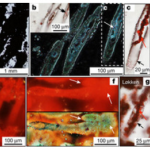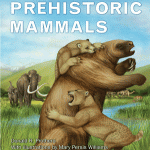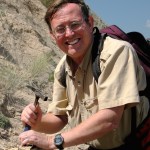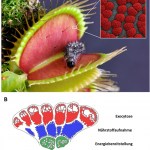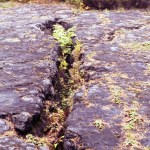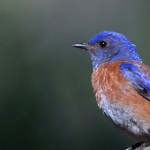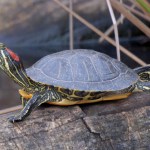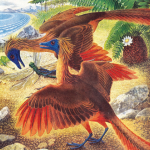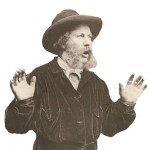Evolutionary Biology
The earliest life must have been something like a small single celled organism, like a bacterium. Or at least, the earliest life that we can usefully conceive of, and potentially connect with living life. It has been suggested that life could have initially evolved at the site of submarine hydrothermal vents, which is a place these days teeming with life. So, it make sense to look for fossils of these early life forms in rocks formed at hydrothermal vents, but a long time ago.
The Nuvvuagittuq belt in Quebec is a geological formation that includes such rock.
There are two basic ways to…
This is a descriptive model of Donald Trump's behavior, which ultimately works out to a prediction that Donald Trump won't last very long. In an evolutionary sense, at least.
I've found that many people use the term "spite" incorrectly. Many assume it has to do with vitriol or nastiness, or otherwise, is motivated negative behavior of some kind. This is not even close to the scientific definition of the term. A daffodil plant can carry out an act of spite, and a daffodil plant is unlikely to engage in motivated behavior.
Spite involves carrying out an act where the ultimate cost to…
The Princeton Field Guide to Prehistoric Mammals ,by Donald R. Prothero, is the first extinct animal book that you, dear reader, are going to give to someone for the holidays.
This book is an interesting idea. Never mind the field guide part for a moment. This isn't really set up like a field guide, though it is produced by the excellent producers of excellent field guides at Princeton. But think about the core idea here. Take every group of mammal, typically at the level of Order (Mammal is class, there are more than two dozen living orders with about 5,000 species) and ask for each one, "…
The latest in GMO technology: Photosynthesizing Human Beans!
This is silly, but makes some good points. May be good for teachers in your biology class:
Ikonokast interviews Don Prothero.
Don Prothero is the author of just over 30 books and a gazillion scientific papers covering a wide range of topics in paleontology and skepticism. Mike Haubrich and I spoke with Don about most of these topics, including the recent history of the skeptics movement, the conflict and potentials between DNA and fossil research, extinctions and impacts, evolution in general, and the interesting projects Don is working on now.
The interview is here. Please click through and give this fascinating conversation a listen!
The trick to understanding evolution is less about finding good answer to questions, but rather, finding good questions to answer.
Read that sentence twice, because it is very important.
Years ago, Niko Tinbergen developed a method of formulating questions about biology. I'm pretty sure the Tinbergenian method has not been integrated into most science standards and teaching curriculum. It should be.
There are four types of questions one could formulate about a biological system, trait, or observation.
1) Mechanistic. How does this thing work? What cellular processes are involved in a…
Sean B. Carroll is coming out with a new book called The Serengeti Rules: The Quest to Discover How Life Works and Why It Matters.
This is the molecular biologist Sean Carroll, as distinct from the physicist (who wrote this).
Homeostasis is one of the basic principles of biology. The term can be applied broadly to mean that certain numbers are maintained within a certain range. This could refer to energy flowing through a system, numbers of specific cellular products like enzymes, numbers of individual organisms in an ecological system, etc. It is not so much that numbers don't change.…
During the holiday season, Kim, Liz and I are taking a short break from blogging. We are posting some of our favorite posts from the past year. Here’s one of them, originally posted on May 27, 2015:
by Kim Krisberg
For more than a decade, biologist Mariam Barlow has been working on the theory that administering antibiotics on a rotating basis could be a solution to antibiotic resistance. After years of research, Barlow had lots of data, but she needed a more precise way to make sense of it all — something that was so specific it could easily be used to treat patients. So, she joined…
This is a review of The Story of Life in 25 Fossils: Tales of Intrepid Fossil Hunters and the Wonders of Evolution.
Don Prothero
Fossils are cool. Why? Two very big and complex reasons. First, fossils allow us to reconstruct species that don’t exist any more. This is usually done by studying species that do exist, and using the information we glean from living things to interpret the details of the fossil species, giving it life. Second, fossils tell us about evolutionary change, both by showing us what evolutionary events happened that we would not be able to see in living species, and…
Over the last several months, a lot of great books on fossils and evolution (as in paleontology) have come out. I've selected the best for your consideration. These are great gifts for your favorite science-loving nephew, life science teaching cousin, or local school library. Actually, you might like some of these yourself.
Let's start off with a kid's book: Grandmother Fish: a child's first book of Evolution by Jonathan Tweet.
From the blurb:
Grandmother Fish is the first book to teach evolution to preschoolers. While listening to the story, the child mimics the motions and sounds of our…
For more than a decade, biologist Mariam Barlow has been working on the theory that administering antibiotics on a rotating basis could be a solution to antibiotic resistance. After years of research, Barlow had lots of data, but she needed a more precise way to make sense of it all — something that was so specific it could easily be used to treat patients. So, she joined forces with a team of mathematicians. And the amazing results could help solve an enormous, worldwide problem.
In a nutshell, the team of biologists and mathematicians developed a software program that generates a road map…
This is one of those great examples of research you can probably use in an advanced biology classroom (high school) or intro college bio pretty effectively. It includes birds. It includes hormones. It includes evolution. What else is there, really?
I did a very brief writeup on it here, and you can get the original paper which is very straight forward and readable.
The bottom line: Females in one species of bird manage to figure out that under certain, occasional conditions if they produce really obnoxious and overbearing sons, those sons will do well. So they do. There is a phylogenetic…
Some interesting new research. The paper is, unfortunately, behind a paywall but they made a video, so it is worth posting.
Here's the press release for the paper:
Scientists know that temperature determines sex in certain reptiles—alligators, lizards, turtles, and possibly dinosaurs. In many turtles, warm temperatures during incubation create females. Cold temperatures, males. But no one understands why.
A recent study sheds further light on this question. The findings of researchers Kayla Bieser, assistant professor at Northland College, and Thane Wibbels, professor of reproductive biology…
There are over 10,000 species of bird on the Earth today. There is one blog called "10,000 Birds" for which I write a monthly article, in case you did not know. But this post is about Ten Thousand Birds: Ornithology Since Darwin, a book by Tim Birkhead, Jo Wimpenny and Bob Monegomerie.
Birds and various studies of birds are central to evolutionary theory and the development of all of the surrounding biology and science. Here's a short list of key roles birds have played in evolutionary biology:
Darwin's study of pigeon breeding was central to On the Origin of Species and later works.
The…
In a previous life (of mine) my father-in-law, an evolutionary biologist, kept an oil painting of a fish on the wall of the living room. At every chance he would point out, to visitors or to anyone else if there were no visitors, that he kept a portrait of his distant ancestor hanging in a prominent location, pointing to the oil painting. It was funny even the third or fourth time. It isn't really true, of course, that this was his ancestor. It was a bass, more recently evolved to its present form than humans, I suspect. But it is true that the last common ancestor of humans and fish was a…
Humans appear to have a reasonable amount of diversity in their sexual orientations, in what is often referred to as "gender" and in adult behavior generally. When convenient, people will point to "genes" as the "cause" of any particular subset of th is diversity (or all of it). When convenient, people will point to "culture" as the "cause" of ... whatever. The "real" story is more complicated, less clear, and very interesting. And, starting now, I promise to stop using so many "scare" quotes.
Prior to birth there are a number of factors than can influence things like gender or sexuality…
Behaviors are not caused by genes. There is not a gene that causes you to be good, or to be bad, or to be smart, or good at accounting, or to like bananas. There are, however, drives. "Drives" is a nicely vague term that we can all understand the meaning of. Thirst and hunger are drives we can all relate to. In fact, these drives are so basic, consistent and powerful that almost everyone has them, we share almost exact experiences in relation to them, and they can drive (as drives are wont to do) us to do extreme things when they are not met for long periods of time. While eating…
I heard it said recently that "Evolution" and "Origin of life" are two separate issues. I know that this is a falsehood, and I'll discuss in a moment how and why it is not true. But first, I checked around with a few people that I know and love, and found out that some of them assumed this was true. I think it is something that has been said enough times that if you are not personally engaged in the research or just don't think about it enough, you can easily assume that this is what the experts say. But they don't.
It is possible that there is a nefarious force working here. And I'm…
Welcome to the Thirty Sixth Carnival of Evolution. The world of blog carnivals is in a state of flux and uncertainty these days, with the distinct possibility of a mass extinction just around the corner. One of the oldest, longest running, and most important carnivals, I and the Bird, issued its last issue only a few days ago, and the Keepers of the Carnival of Evolution themselves are said to be thinking about ways that this whole carnival thing can be made to work better. That could, I suppose, mean killing it and replacing it with something else. We are hopeful that this will not be…
These are the kinds of books you get if you are either a scientists studying bird migration and related issues, or a very serious bird geek. The first two can be obtained at very low prices used, but the third will set you back at least 50 bucks US$ if you want a used copy. Note the spread of publication dates. It is not the case that the oldest book is out of date in all respects: Quite the contrary. Alerstam reviews theory and ideas that have not been revisited or revised to any great degree. Also, it is interesting to see how changes in the field develop over a decade or so. In any…
